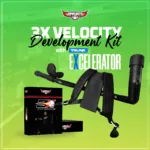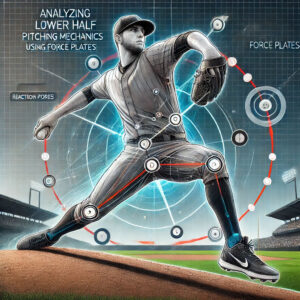 If you want information on Using Force Plates to Train Pitchers, this is the article for you!
If you want information on Using Force Plates to Train Pitchers, this is the article for you!
The Prevalence of Shoulder and Elbow Injuries in Youth Baseball
Shoulder and elbow injuries are alarmingly common in baseball players, particularly pitchers. These injuries are not only painful but can also sideline players for extended periods, impacting their development and career prospects. Overuse injuries, such as Little League shoulder and elbow, occur due to repetitive stress on the joints and tendons. These injuries are increasingly prevalent among younger athletes, a trend that underscores the urgent need for comprehensive biomechanical research at the youth level. Addressing these issues early can prevent long-term damage and promote healthier athletic careers.
Importance of Lower Body Mechanics in Pitching
While extensive research has focused on upper body kinematics and kinetics, the lower body's role in pitching mechanics is equally critical. The lower half's dynamic actions are fundamental to generating and transferring kinetic energy, ultimately affecting pitch velocity and overall performance. The drive leg (back leg) initiates the motion, creating forward momentum, while the stride leg (front leg) provides stability and supports the rotational forces necessary for an effective pitch. Proper lower body mechanics ensure efficient energy transfer from the ground through the body to the ball, reducing the risk of injury and enhancing performance. Understanding and optimizing these mechanics can lead to significant improvements in pitching effectiveness and athlete longevity.
Understanding Ground Reaction Forces (GRF) and Energy Flow (EF)
 Ground Reaction Forces (GRF): Using Force Plates to Train Pitchers
Ground Reaction Forces (GRF): Using Force Plates to Train Pitchers
Ground Reaction Forces (GRF) refer to the forces exerted by the ground on a body in contact with it. In the context of pitching, these forces are critical for initiating and sustaining movement. When a pitcher pushes off the mound, the ground reaction forces generated by their legs create the necessary momentum to drive the body forward. This forward motion is essential for generating the kinetic energy that is transferred up through the body to the throwing arm.
GRF is not a single, static force but a dynamic interaction that varies throughout the pitching motion. It includes both vertical forces, which help maintain balance and support the body against gravity, and horizontal forces, which drive the body forward and stabilize it during the pitch. Properly harnessing GRF can enhance a pitcher's velocity and control while reducing the risk of injury by ensuring that energy is efficiently transferred from the lower body to the upper body.
Energy Flow (EF): Using Force Plates to Train Pitchers
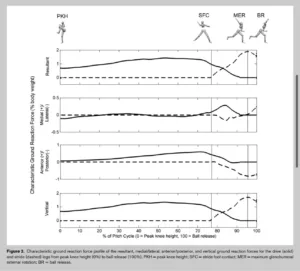 Energy Flow (EF) quantifies the transfer of mechanical energy between body segments during dynamic actions like pitching. It provides a comprehensive view of how kinetic energy, generated by muscle contractions and ground interactions, is transferred throughout the body to achieve the desired athletic performance.
Energy Flow (EF) quantifies the transfer of mechanical energy between body segments during dynamic actions like pitching. It provides a comprehensive view of how kinetic energy, generated by muscle contractions and ground interactions, is transferred throughout the body to achieve the desired athletic performance.
In pitching, EF involves the coordinated transfer of energy from the lower extremities (legs) through the core (pelvis and trunk) and into the upper extremities (arm and hand). This transfer is critical for maximizing pitch velocity and accuracy. EF analysis helps identify how effectively a pitcher uses their entire body to generate and transfer energy, highlighting areas where efficiency can be improved.
EF can be broken down into linear and rotational components, each playing distinct roles in the pitching motion. Linear energy transfer involves the forward motion created by the drive leg, while rotational energy transfer involves the twisting motion of the pelvis and trunk that helps whip the arm through the pitching motion. Understanding these components allows coaches and athletes to fine-tune their mechanics, ensuring that each segment of the body contributes optimally to the overall movement.
By analyzing GRF and EF together, researchers and coaches can gain deeper insights into the biomechanics of pitching. This holistic approach can lead to more effective training programs that enhance performance while minimizing the risk of injury.
Lower Body Mechanics in Pitching: Using Force Plates to Train Pitchers
 Role of the Drive Leg: Using Force Plates to Train Pitchers
Role of the Drive Leg: Using Force Plates to Train Pitchers
The drive leg, or back leg, plays a pivotal role during the initial phases of the pitching motion. This leg is responsible for generating the forward motion of the entire body, which is crucial for creating the necessary momentum for a powerful fastball.
When the pitcher begins their motion, the drive leg pushes off the pitching rubber, creating a force against the ground. This force propels the body forward and initiates the kinetic chain reaction that leads to the pitch. The strength and timing of this push-off are critical; a strong and well-timed push-off can lead to a faster and more powerful fastball.
Additionally, the drive leg's action helps to maintain balance and stability during the initial stages of the motion. Proper utilization of the drive leg ensures that the pitcher can maintain an optimal posture and alignment, which is necessary for efficient energy transfer through the body.
Role of the Stride Leg: Using Force Plates to Train Pitchers
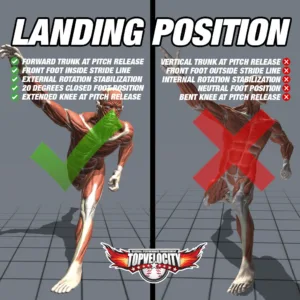 The stride leg, or front leg, establishes a stable base as the pitcher moves forward. This leg plays a crucial role in the later stages of the pitching motion, particularly during the arm cocking and acceleration phases.
The stride leg, or front leg, establishes a stable base as the pitcher moves forward. This leg plays a crucial role in the later stages of the pitching motion, particularly during the arm cocking and acceleration phases.
As the pitcher strides forward, the stride leg extends and plants firmly on the ground. This action creates a stable base that allows the pelvis and trunk to rotate effectively. The rotation of the pelvis and trunk is a key component of the pitching motion, as it helps to generate rotational energy that is transferred to the upper body and ultimately to the throwing arm.
The stability provided by the stride leg is essential for maintaining balance throughout the pitch. A stable stride leg ensures that the pitcher can control their body movements and maintain a consistent delivery. This stability also helps to maximize the transfer of energy from the lower body to the upper body, enhancing pitch velocity and accuracy.
Moreover, the stride leg acts as a braking mechanism, helping to decelerate the forward motion of the body. This deceleration is important for protecting the pitcher's joints, particularly the shoulder and elbow, from excessive stress and potential injury.
In summary, the drive leg and stride leg work together to create a powerful and efficient pitching motion. The drive leg generates forward momentum and maintains balance in the early stages, while the stride leg provides stability and facilitates rotational energy transfer in the later stages. Understanding and optimizing the mechanics of both legs is essential for enhancing pitching performance and reducing the risk of injury.
Correlations between GRF and Pitching Performance
 Conflicting Findings in Previous Research
Conflicting Findings in Previous Research
Studies investigating the relationship between GRF and pitch velocity have yielded mixed results. Some research found significant correlations between peak propulsive GRF and ball velocity, while others did not. These inconsistencies highlight the need for a more detailed analysis of GRF kinetics.
GRF Impulse vs. Peak GRF
Focusing solely on peak GRF provides a limited view of the interaction between the pitcher and the ground. GRF impulse, which considers the overall profile of the force–time curve, offers a more comprehensive understanding of the forces involved in pitching.
Importance of GRF Impulse
GRF impulse is a key performance indicator for dynamic motions, as it reflects the sustained application of force. This measure is particularly relevant in baseball pitching, where rapid acceleration and deceleration of the body are required.
Energy Flow Analysis in Pitching
 EF and Segmental Energy Transfer
EF and Segmental Energy Transfer
EF analysis allows researchers to quantify the transfer of mechanical energy between body segments, offering insights into the efficiency of the kinetic chain in pitching.
Correlations with Pitching Velocity
Research has shown that EF between the arm and trunk segments is highly correlated with pitching velocity. Efficient energy transfer from the lower extremities to the trunk enhances joint load efficiency, contributing to better performance and reduced injury risk.
EF Components: Linear and Rotational Kinetic Energy
EF components arise from net joint force and net joint moment powers. Understanding the contributions of linear and rotational kinetic energy transfer between segments provides a deeper understanding of pitching biomechanics and upper extremity loading.
Training Ground Forces and Optimal Energy Flow in the Kinetic Chain
 The Stride Excelerator: Enhancing Lower-Body Mechanics
The Stride Excelerator: Enhancing Lower-Body Mechanics
The Stride Excelerator is an integral part of the TopVelocity Exceleration Package, designed to optimize lower-half movement, a critical component in generating ground reaction forces (GRF) during the pitching motion. By focusing on the mechanics of the stride leg, this innovative tool helps pitchers create a stable and powerful base, essential for transferring kinetic energy from the lower body through the kinetic chain.
Key Benefits:
- Increased Velocity: By training the stride leg to effectively generate and manage GRF, the Stride Excelerator can add 5+ mph to your throwing velocity. It ensures that the force exerted against the ground is maximized and correctly directed, enhancing forward momentum and pitch power.
- Enhanced Stability: Proper use of the Stride Excelerator improves the stability of the stride leg, crucial for maintaining balance and control during the pitching motion. This stability allows for more efficient energy transfer from the lower body to the upper body.
- Optimal Technique: The Stride Excelerator's drills and exercises are meticulously designed to refine the lower-body mechanics, ensuring that pitchers achieve optimal stride length, angle, and timing for maximum performance.
The Trunk Excelerator: Maximizing Energy Transfer
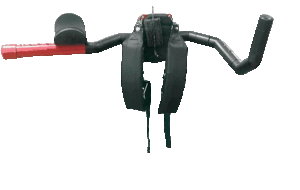 Complementing the Stride Excelerator, the Trunk Excelerator focuses on the core, or trunk, of the body, a vital area for efficient energy transfer and enhanced power in the pitching motion. The trunk acts as a bridge between the lower and upper body, and its ability to transfer energy efficiently is crucial for generating high pitching velocities.
Complementing the Stride Excelerator, the Trunk Excelerator focuses on the core, or trunk, of the body, a vital area for efficient energy transfer and enhanced power in the pitching motion. The trunk acts as a bridge between the lower and upper body, and its ability to transfer energy efficiently is crucial for generating high pitching velocities.
Key Benefits:
- Efficient Energy Transfer: The Trunk Excelerator trains the trunk muscles to transfer kinetic energy from the lower body to the throwing arm more efficiently. This transfer is essential for maximizing pitch velocity and reducing stress on the arm.
- Improved Rotational Power: By focusing on the rotational aspects of the trunk, the Trunk Excelerator helps pitchers develop greater rotational power. This power is crucial during the arm cocking and acceleration phases of the pitch, where the trunk's rotation significantly influences the speed and power of the throw.
- Enhanced Core Strength: Strengthening the core muscles with the Trunk Excelerator provides a solid foundation for all movements, reducing the risk of injury and improving overall athletic performance.
Comprehensive Training Program
The TopVelocity Exceleration Package includes a comprehensive training program that leverages both the Stride and Trunk Excelerators. This program is designed with drills and exercises that integrate the use of these tools, ensuring that pitchers develop optimal technique and maximize performance gains.
Instructional Videos
Step-by-step instructional videos accompany the training program, providing visual guidance to perfect each drill. These videos ensure that athletes perform the exercises correctly and effectively, leading to better results and a deeper understanding of the mechanics involved.
Performance Enhancement and Competitive Edge
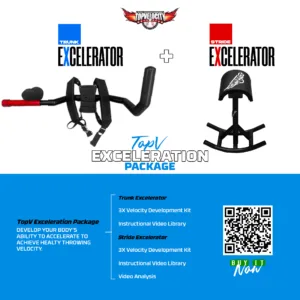 Utilizing the Stride and Trunk Excelerators as part of the TopVelocity Exceleration Package provides a significant competitive edge. By improving pitching velocity, precision, and overall throwing prowess, athletes can elevate their game and stand out to coaches, scouts, and teammates.
Utilizing the Stride and Trunk Excelerators as part of the TopVelocity Exceleration Package provides a significant competitive edge. By improving pitching velocity, precision, and overall throwing prowess, athletes can elevate their game and stand out to coaches, scouts, and teammates.
Performance Enhancement:
- Pitching Velocity: Targeted development of lower-body and trunk mechanics translates directly into increased pitching velocity.
- Precision: Improved stability and energy transfer lead to more consistent and precise pitches.
- Overall Throwing Prowess: Comprehensive training enhances overall throwing mechanics, making athletes formidable forces on the field.
Competitive Edge:
Equipped with cutting-edge tools, knowledge, and techniques, athletes using the TopVelocity Exceleration Package can showcase superior skills that set them apart from the competition. This package is designed to unlock elite pitching velocity and help athletes achieve their baseball dreams.
Get Started with the TopVelocity Exceleration Package
Unlock the full potential of your baseball performance with the TopVelocity Exceleration Package. Order now and take the first step towards achieving unparalleled training and innovation. For assistance or inquiries, contact TopVelocity at 415-877-4850. Our experts are ready to support your journey to peak performance.
Order the TopVelocity Exceleration Package Now
Conclusion: Using Force Plates to Train Pitchers
Key Insights for Coaches and Athletes: Using Force Plates to Train Pitchers
Understanding the distinct roles of the drive and stride legs in pitching mechanics can inform targeted training interventions. Emphasizing proper mechanics and force application in both legs can enhance performance and reduce injury risks.
Future Research Directions: Using Force Plates to Train Pitchers
Future research should explore the long-term impact of lower half mechanics training on pitching performance and injury prevention, incorporating a diverse range of participants to validate and expand upon these findings.
Frequently Asked Questions: Using Force Plates to Train Pitchers
What are ground reaction forces (GRF) in pitching?
GRF are the forces exerted by the ground on the body during pitching, essential for understanding how energy is generated and transferred through the body.
How does the drive leg contribute to pitching mechanics?
The drive leg plays a crucial role in generating forward motion and transferring linear power through the pelvis and trunk, influencing the overall velocity and efficiency of the pitch.
Why is GRF impulse important in pitching mechanics?
GRF impulse, which measures the sustained application of force over time, provides a more comprehensive understanding of the forces involved in pitching, offering insights into the efficiency of energy transfer and overall performance.
What can coaches do to improve lower half mechanics in pitchers?
Coaches should focus on developing balanced lower body mechanics, emphasizing proper force application and mechanics of both the drive and stride legs to enhance performance and prevent injuries.


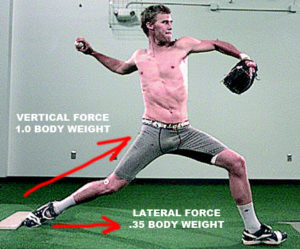 Ground Reaction Forces (GRF): Using Force Plates to Train Pitchers
Ground Reaction Forces (GRF): Using Force Plates to Train Pitchers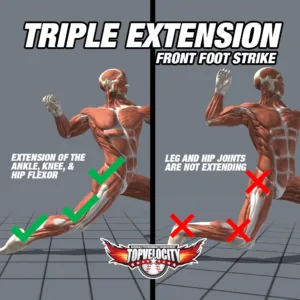 Role of the Drive Leg: Using Force Plates to Train Pitchers
Role of the Drive Leg: Using Force Plates to Train Pitchers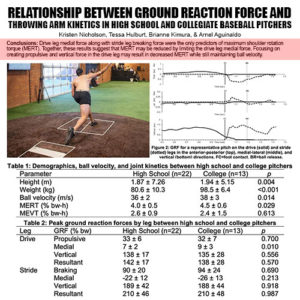 Conflicting Findings in Previous Research
Conflicting Findings in Previous Research EF and Segmental Energy Transfer
EF and Segmental Energy Transfer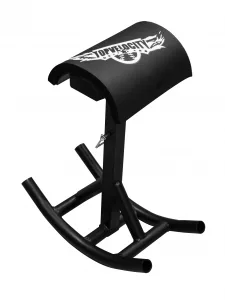 The Stride Excelerator: Enhancing Lower-Body Mechanics
The Stride Excelerator: Enhancing Lower-Body Mechanics
